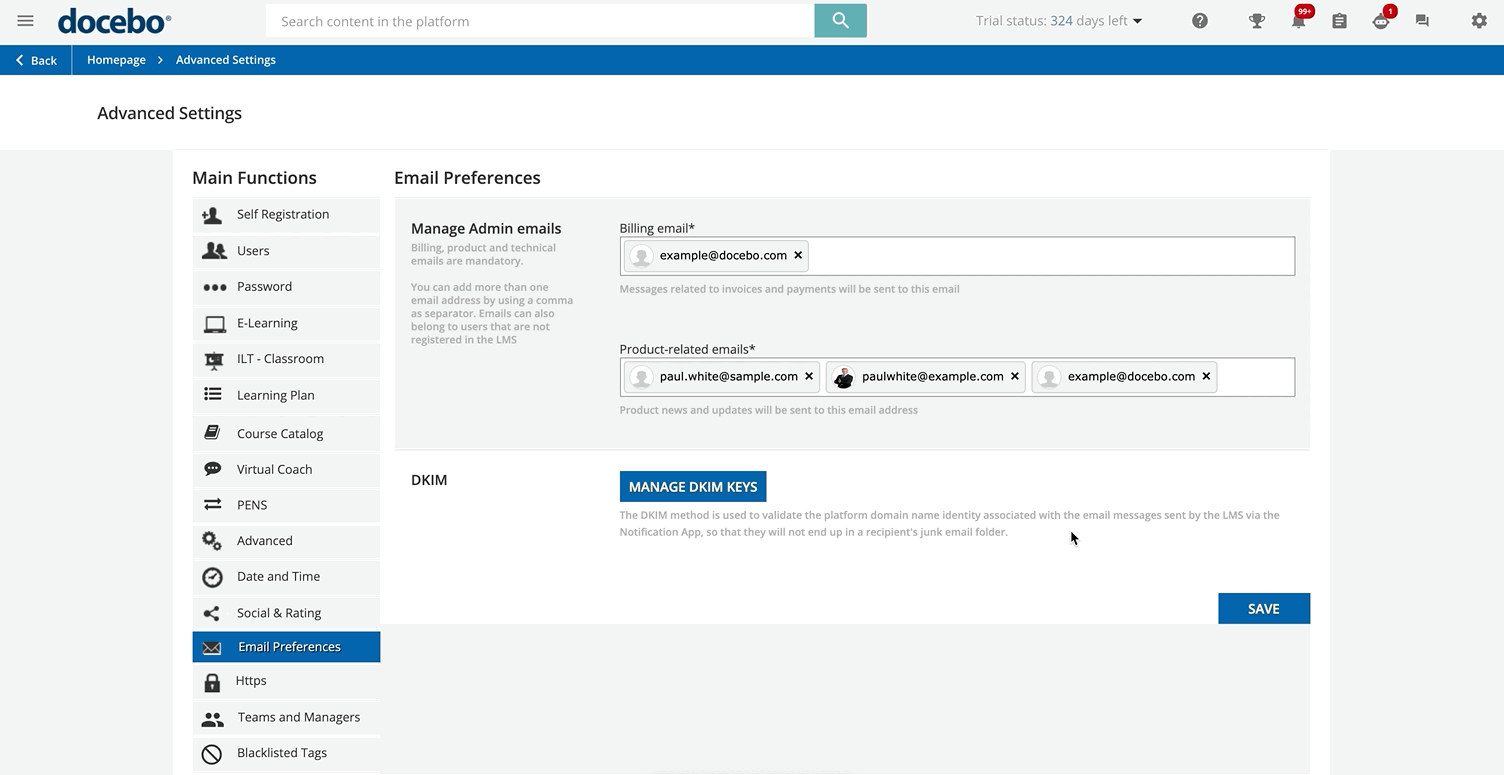DKIM (DomainKeys Identified Mail) is a method of signing electronic emails using public-private key. DKIM is used by receiving mail server for identifying email, that they are sent by authorized mail servers. It also minimizes the possibility of getting emails SPAM.

- Next you’ll use an online wizard to create the DKIM public / private key pairing and the policy record. The ‘public’ key is a key that will be placed in your public-facing DNS record along with.
- Generating the private and public keys. Open the terminal and type openssl. To generate a private key type: openssl genrsa -out private.key 1024 3. To generate a public key from the private key type: openssl rsa -in private.key -pubout -out public.key. Find the folder that contains your public key and open it. It should look something.
- DKIM record generator is an online tool to create DKIM DNS record to protect your domain from email scam and phishing.
This tutorial will provide you a quick and easy way to set up DomainKeys with your POSTFIX running on CentOS and RHEL systems. Clash of clans level 8 trophy base.
To install the public key, Log into the server, edit the authorizedkeys file with your favorite editor, and cut-and-paste the public key output by the above command to the authorizedkeys file. Configure PuTTY to use your private key file (here keyfile.ppk). Then test if login works. See configuring public key authentication for.
How DKIM Works ?
When we configured DKIM on sending servers. First, we generated a public/private key pair for signing outgoing messages. The public key is configured as TXT record on a domains name server, and the private key is configured in the outbound email server. When an email is sent by an authorized user of the email server, the server uses the stored private key to generate a digital signature of the message, which is inserted in the message as a header, and the email is sent as normal.
Step 1 – Install DKIM-milter
First make sure you have enabled EPEL repository in your system. After that install dkim-milter package using following command.
Step 2 – Generate Key Pair
Now create DKIM key pair using dkim-genkey command line utility provided by dkim-milter package. For this tutorial we are using domain name “example.com”, Change this name with your actual names.
Above command will generate two files default.private and default.txt. You can created multiple DKIM keys for different-2 domains and configure with your postfix server.
Now set the proper permissions on Keys directory.
Step 3 – Configure OpenDKIM
Edit the Opendkim configuration file and Add/Update following entries in file.
Then edit the domain keys lists setting file /etc/opendkim/KeyTable and add following entry.
After that edit /etc/opendkim/SigningTable file and update following entry.
And edit /etc/opendkim/TrustedHosts file and update following entry.
Step 4 – Configure Postfix
Now edit POSTFIX configuration file /etc/postfix/main.cf and add following values at the end of file
finally start DKIM service using following command
Step 5 – Configure DNS Entry
After configuring private key in postfix server. there will be another file /etc/opendkim/keys/example.com/default.txt/strong> generated by opendkim-genkey. Edit your DNS zone file and add this as TXT record found in default.txt. In my case this is like below.
Step 6 – Verify DKIM
To verify that DKIM is working properly. Let’s send a test email through command line
In the received email in our mailbox, open the source of the email and search for 'DKIM-Signature'. You will find something like below
Generating the private and public keys
1. Open the terminal and type openssl
2. To generate a private key type:
Need for speed ppsspp cso. Need For Speed Most Wanted PPSSPP CSO fully Compressed! Game version NFS is best racing series to play on Android/PPSSPP. NFS Most Wanted has its own racing uniqueness! & The best part is it is in Highly Compressed in size of 140MB it is the best choice for the racing game on PSP.

openssl genrsa -out private.key 2048
3. To generate a public key from the private key type:
openssl rsa -in private.key -pubout -out public.key
4. Find the folder that contains your public key and open it. It should look something like the below.
5. Manually convert the highlighted text above to a single line ie. remove the spaces between new lines.
Creating the DNS record
The generated 2048 bits DKIM public key is too long to fit into a single TXT DNS record. A DNS record can be up to 255 characters. Therefore your public key will need to be split into two separate TXT records using quotes and slash or brackets and quotes as shown below.
Note: this depends on your DNS provider.
TXT 'part one' 'part two'
TXT ( 'part one' 'part two' )
To create the DNS record you will have to specify the Name, Type and Value of the DNS record.
The DNS record Name will look like this:
selector._domainkey.domain
How To Generate Dkim Public Keywords

Where the 'selector' is defined by you and can be called anything, for example the date, device or service that will sign the emails.
For example:
20180719._domainkey.redsift.io
The DNS record Type is TXT.
The DNS record Value should look like the below. The part in bold is copied from the generated public key file and remember that you will need to split the public key into two records.
Splitting examples:
Example 1 using quotes.
TXT record 1:
“v=DKIM1; k=rsa; p=MIIBIjANBgkqhkiG9w0BAQEFAAOCAQ8AMIIBCgKCAQEAlTtO1qRFaK955gz16Y8c1EMCqtaT4exCrwfor2yT438ZVjrUcqo2tPUNR4eqkD+xcKRQnWSw931uVUY6YJWtOrgrXTIrHnTkf5Xtg+jaXr0OhjdeVDIG/Le7oOVWncMf+9J4ZSRybOpb+XZPp/JLjis6pmC”
TXT record 2: “Lrt5j82yBC9DCbsEPSOVVOC1mr5lq8irQs+qAv6M/DnjNcUrdiRBJyNrs2lfuvfs8BFceZAk1AwcVBcYCmZl5OkxZBn8liTC34FPJLLHm6jMp9+c0OaEtxo8zr3QX0ZYEWC3XqZ/p9fo4Pcg+fpyjee79wBVqUzhVAWdzE5+qAIn4e1Dmslyb6IX4mwIDAQAB”
Example 2 using bracket and quotes.
TXT record 1:
Generate Dkim Record
(“v=DKIM1; k=rsa; p=MIIBIjANBgkqhkiG9w0BAQEFAAOCAQ8AMIIBCgKCAQEAlTtO1qRFaK955gz16Y8c1EMCqtaT4exCrwfor2yT438ZVjrUcqo2tPUNR4eqkD+xcKRQnWSw931uVUY6YJWtOrgrXTIrHnTkf5Xtg+jaXr0OhjdeVDIG/Le7oOVWncMf+9J4ZSRybOpb+XZPp/JLjis6pmC”
Generate Dkim Key Pair
TXT record 2: “Lrt5j82yBC9DCbsEPSOVVOC1mr5lq8irQs+qAv6M/DnjNcUrdiRBJyNrs2lfuvfs8BFceZAk1AwcVBcYCmZl5OkxZBn8liTC34FPJLLHm6jMp9+c0OaEtxo8zr3QX0ZYEWC3XqZ/p9fo4Pcg+fpyjee79wBVqUzhVAWdzE5+qAIn4e1Dmslyb6IX4mwIDAQAB”)
